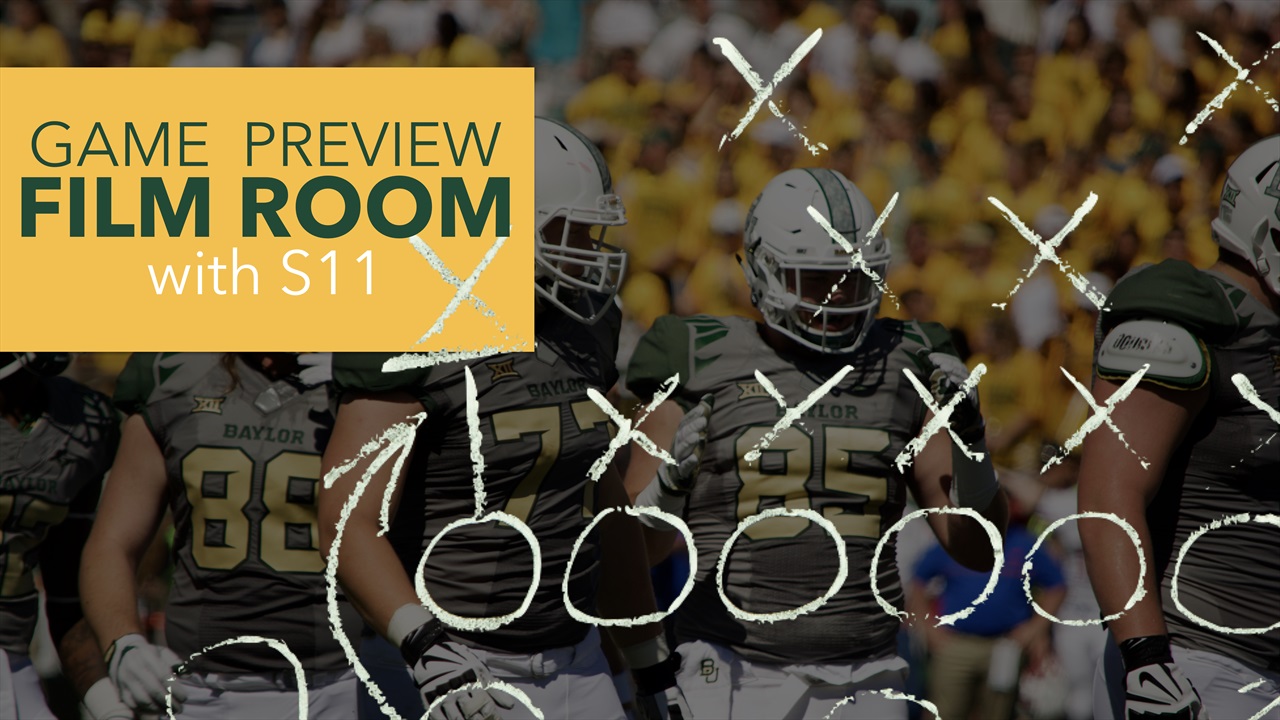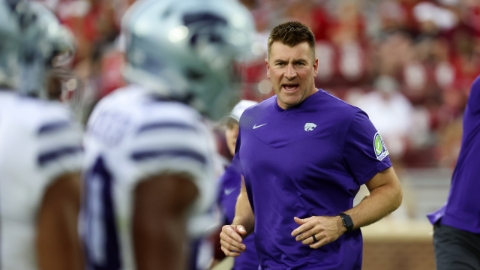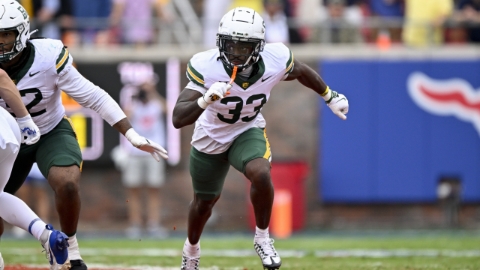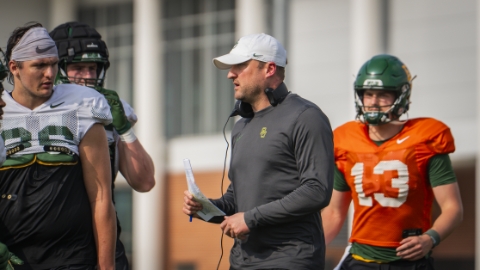Tomorrow I will drop part two which gets into how Bennett might scheme against this.

More: A Baylor v. Texas Hype Video | Create a free account today!
Baylor heads to Austin for one of the more interesting Big 12 matchups of the year. Obviously the bad blood from the offseason will be a storyline but for me the biggest spectable will be the mirror-match: It's the Briles offensive scheme against the Briles offensive scheme for the first time ever! Both teams may share offensive systems but the defensive philosophies are quite different and we begin our look at the Longhorns on that side of the ball.
Coach Charlie Strong opened the year with a very publicized victory over Notre Dame that broke Nielsen records for the last decade but the records of the two teams dropped below expectations since and the 'Horns enter Saturday with a 3-4 record having added wins over Iowa State and UTEP. Strong is the former defensive coordinator for Lou Holtz and Urban Meyer who turned a Louisville program from rags to riches. He's had a tough time in Austin since succeeding Mack Brown but is trying to turn it around with a young but talented roster.
In coverage Texas is a team that bases out of one high coverages with one deep safety typically in the middle of the field. Cover 3 variations are the main choice for the Longhorns. These typically consist of the deep area of the field being split into thirds with zone coverages underneath. Texas will typically use one safety and the two cornerbacks as their deep defenders. UT will apply some man coverage principles to their Cover 3 zones but Cover 1 (1 deep, man coverage) is also used. One change up that UT likes to go with is to use Cover 2 zone or Cover 2 man on third downs where two defenders split the deep area of the field in half with either zone coverage or man to man underneath.
Below you see an example of UT running a three deep zone while disguising an aggressive blitz look. They make it look like any of six guys could potentially blitz but ultimately two drop back giving UT seven men in coverage. OU does a good job to protect the QB and he does a good job delivering a pass but a dropped pass is intercepted by the Longhorns.
The scheme borrows a lot from what Strong learned under former Notre Dame coach and Texas A&M assistant Bob Davie.
At the interior linebacking spots Texas has two highly touted recruits in starting roles. All everything recruit #46 Malik Jefferson (6-3, 238, So.) brings rare speed to the position and does so with prototype size at the middle linebacker spot. The weakside linebacker #45 Anthony Wheeler (6-2, 228, So.) is a bit smaller but also runs very well. When Texas uses a strongside linebacker they will put #35 Edwin Freeman (6-1, 228, So.) out there who has experience as a defensive back in his career prior to growing into the linebacker position and used that experience to pick of Kansas State last week.
The secondary features two mainstays as the starting safeties. #14 Dylan Haines (6-1, 200, Sr.) and #31 Jason Hall (6-3, 216, Jr.) have seen starter's minutes ever since 2014 and are steady players for UT. The current starting corners are former Baylor targets #24 John Bonney (6-1, 192, So.) and #5 Holton Hill (6-2, 195, So.) although #2 Kris Boyd (6-1, 190, So.) sees time. Last year UT started #9 Davante Davis (6-2, 197, So.) who has not seen as much time this year despite a promising 2015. At Nickel the Longhorns will use one of #11 P.J.̯cke III (5-10, 200, So.), former top recruit #19 Brandon Jones (5-11, 192, Fr.), or #25 Antwuan Davis (6-1, 193, Jr.).
Texas outperformed the other power conference teams per-drive against Notre Dame, Cal, and Iowa State. However Texas under performed against both Oklahoma schools and dramatically under performed per-drive against Kansas State last week giving up over 43 per drive to an offense that averaged 30 against other power conference teams and who's previous best was 37.4 against Texas Tech.
In the red zone Texas gives up around 65% of available points against power conference competition. This is against teams that average 72.6% in their other P5 games.
It's impossible to know exactly how Texas will line up but if last year is any indication they will use their Cover Three scheme to avoid pure man to man situations. Even before Baylor lost literally every scholarship QB the Longhorns dialed up numerous variations on three deep zones and brought different linebacker pressures to disrupt the offense and keep the Baylor receivers from winning the game on two or three plays. Below you see one of Chris Johnson's few passing attempts early on in the game.
During UT's spring game against their version of Baylor's scheme UT mixed in a couple other looks but mostly went with either Cover Three or Cover One. If UT decides to go Cover 1 Baylor will need to take advantage of the single coverage and be ready to make plays. Cannon, Platt, Lynch, Zamora, Hawthorne, and Stricklin need to be able to beat single coverage much like the receiving corps did last year against West Virginia's outstanding secondary.
Texas as a unit has a lot of athletic players who are young and are not fitting their gaps against the run the way they should. Far too often guys freelance or try to do too much. Also early in the season they had a lot of coverage breakdowns on the back end like this play. Here a safety rotates down to be the curl/flat player in Cover 3. He obviously was expecting help that was not there. Either he or his teammate messed up and Oklahoma State benefited from it with an easy score.
I think you need to involve Seth in the running game as his de-facto counterpart is 30 yards downfield in those looks. Combining that with UT's frequent issues defending the run against their better offensive competition should do a lot to get consistent yards. Notre Dame, Oklahoma, and Kansas State all used this to great success against Texas. It's also the same basic idea that made Baylor's emergency offense last year work. By running the ball with whoever was behind center the defense was outnumbered. I would consider using Lynx Hawthorne at QB for a few plays to gain that same benefit while minimizing the number of hits that Seth will take although Russell himself has the ability to break long runs. Below you see clips from each game I reference where teams find success against them by involving the QB as a runner or option reading a defender with him.
If UT runs cover three there should be hitches open underneath the coverage for relatively easy throws but the Bears have to be careful as Texas likely sees these throws in practice and may try and jump them for an interception. Seth's touchdown throw to Chris Platt against OSU was also against Cover 3 so we could see some seam throws.
I also think running RPO plays that read the rolldown safety could be beneficial. Baylor needs to lean on their running game in this one or at least use RPO's to where UT has to play them honest. The wildbear averaged over 50 yards per possession in the second half of last year's game. Using the QB or at least the threat of the QB to outnumber and outleverage the defense at the point of attack makes sense. Texas will obviously try to mix up their looks to get a negative play to disrupt the run but overall I think Baylor can run on them.
I think Baylor has the ability to do all of the above against their base scheme, the adjustments will tell you where the ball needs to go. I think Baylor's receivers can make plays against single coverage and having both the guys you named healthy and ready will be a huge asset. If Texas tries to roll coverage to one I believe that the other will have a huge opportunity. With that said I would rather just control the trenches. It's how Baylor won in Austin last time and it almost let the Bears come from 20 down at the half to win without a quarterback last year.
Friday... the Baylor defense needs to stop another version of the Baylor offense!
Baylor heads to Austin for one of the more interesting Big 12 matchups of the year. Obviously the bad blood from the offseason will be a storyline but for me the biggest spectable will be the mirror-match: It's the Briles offensive scheme against the Briles offensive scheme for the first time ever! Both teams may share offensive systems but the defensive philosophies are quite different and we begin our look at the Longhorns on that side of the ball.
Coach Charlie Strong opened the year with a very publicized victory over Notre Dame that broke Nielsen records for the last decade but the records of the two teams dropped below expectations since and the 'Horns enter Saturday with a 3-4 record having added wins over Iowa State and UTEP. Strong is the former defensive coordinator for Lou Holtz and Urban Meyer who turned a Louisville program from rags to riches. He's had a tough time in Austin since succeeding Mack Brown but is trying to turn it around with a young but talented roster.
LONGHORN DEFENSE
The Longhorn defense runs a multiple front defense. Their defense has three true linemen, and one "FOX" which is their name for a hybrid player that is part time linebacker and part time defensive end. UT will keep the same personnel on the field but alternate between three and four man fronts by moving the FOX around. Below you see how moving him between a line and a linebacker alignment can change UT from a 4-3 style defense to a 3-3 stack.In coverage Texas is a team that bases out of one high coverages with one deep safety typically in the middle of the field. Cover 3 variations are the main choice for the Longhorns. These typically consist of the deep area of the field being split into thirds with zone coverages underneath. Texas will typically use one safety and the two cornerbacks as their deep defenders. UT will apply some man coverage principles to their Cover 3 zones but Cover 1 (1 deep, man coverage) is also used. One change up that UT likes to go with is to use Cover 2 zone or Cover 2 man on third downs where two defenders split the deep area of the field in half with either zone coverage or man to man underneath.
Below you see an example of UT running a three deep zone while disguising an aggressive blitz look. They make it look like any of six guys could potentially blitz but ultimately two drop back giving UT seven men in coverage. OU does a good job to protect the QB and he does a good job delivering a pass but a dropped pass is intercepted by the Longhorns.
The scheme borrows a lot from what Strong learned under former Notre Dame coach and Texas A&M assistant Bob Davie.
PERSONNEL
Texas as usual is one of the most talented teams in the country. This roster has guys at every level of the defense that most of the Big 12 wanted and does not have many weaknesses in athletic ability. Their defensive line has two guys who have started at nose tackle, #93 Paul Boyette Jr. (6-3, 317, Sr.) and #97 Chris Nelson (6-1, 297, So.) who both bring good strength and athletic ability to the position. Their starter at defensive tackle is the quick and athletic #95 Poona Ford (5-11, 303, Jr.) who is shorter than most people at his position but compensates with quickness and strength. The promising young starter at the strong end position is #90 Charles Omenihu (6-6, 254, So.) who has grown into his large frame while maintaining his speed. The FOX position at UT has three main players. #40 Naashon Hughes (6-4, 237, Jr.), former Baylor commit #44 Breckyn Hager (6-3, 227, So.), and touted freshman #32 Malcolm Roach (6-2, 263, Fr.) all see time at the position. Occasionally UT will play two at the same time.At the interior linebacking spots Texas has two highly touted recruits in starting roles. All everything recruit #46 Malik Jefferson (6-3, 238, So.) brings rare speed to the position and does so with prototype size at the middle linebacker spot. The weakside linebacker #45 Anthony Wheeler (6-2, 228, So.) is a bit smaller but also runs very well. When Texas uses a strongside linebacker they will put #35 Edwin Freeman (6-1, 228, So.) out there who has experience as a defensive back in his career prior to growing into the linebacker position and used that experience to pick of Kansas State last week.
The secondary features two mainstays as the starting safeties. #14 Dylan Haines (6-1, 200, Sr.) and #31 Jason Hall (6-3, 216, Jr.) have seen starter's minutes ever since 2014 and are steady players for UT. The current starting corners are former Baylor targets #24 John Bonney (6-1, 192, So.) and #5 Holton Hill (6-2, 195, So.) although #2 Kris Boyd (6-1, 190, So.) sees time. Last year UT started #9 Davante Davis (6-2, 197, So.) who has not seen as much time this year despite a promising 2015. At Nickel the Longhorns will use one of #11 P.J.̯cke III (5-10, 200, So.), former top recruit #19 Brandon Jones (5-11, 192, Fr.), or #25 Antwuan Davis (6-1, 193, Jr.).
STATISTICS
Statistically Texas is not doing very well this season on defense. However with the exception of UTEP and Iowa State the Longhorns have faced solid to strong offenses every week. One statistic I looked at was Texas compared to what other Power 5 teams have averaged against their competition in terms of yards per drive. (Notre Dame vs NC State was omitted from both the offensive and defensive statistics due to a hurricane making this game an outlier.). Overall UT gave up around 1-2% more yards per drive than teams earned against other power five competition.Texas outperformed the other power conference teams per-drive against Notre Dame, Cal, and Iowa State. However Texas under performed against both Oklahoma schools and dramatically under performed per-drive against Kansas State last week giving up over 43 per drive to an offense that averaged 30 against other power conference teams and who's previous best was 37.4 against Texas Tech.
In the red zone Texas gives up around 65% of available points against power conference competition. This is against teams that average 72.6% in their other P5 games.
The Baylor scheme is a bit unique. How will Texas likely defend it?
It's impossible to know exactly how Texas will line up but if last year is any indication they will use their Cover Three scheme to avoid pure man to man situations. Even before Baylor lost literally every scholarship QB the Longhorns dialed up numerous variations on three deep zones and brought different linebacker pressures to disrupt the offense and keep the Baylor receivers from winning the game on two or three plays. Below you see one of Chris Johnson's few passing attempts early on in the game.
During UT's spring game against their version of Baylor's scheme UT mixed in a couple other looks but mostly went with either Cover Three or Cover One. If UT decides to go Cover 1 Baylor will need to take advantage of the single coverage and be ready to make plays. Cannon, Platt, Lynch, Zamora, Hawthorne, and Stricklin need to be able to beat single coverage much like the receiving corps did last year against West Virginia's outstanding secondary.
Texas has arguably as much raw talent as anyone in the Big 12 but aren't in the top tier of league defenses. What's the issue with the Longhorn defense?
Texas as a unit has a lot of athletic players who are young and are not fitting their gaps against the run the way they should. Far too often guys freelance or try to do too much. Also early in the season they had a lot of coverage breakdowns on the back end like this play. Here a safety rotates down to be the curl/flat player in Cover 3. He obviously was expecting help that was not there. Either he or his teammate messed up and Oklahoma State benefited from it with an easy score.
If Texas comes out in their single deep safety coverages that they base out of, how would you attack them?
I think you need to involve Seth in the running game as his de-facto counterpart is 30 yards downfield in those looks. Combining that with UT's frequent issues defending the run against their better offensive competition should do a lot to get consistent yards. Notre Dame, Oklahoma, and Kansas State all used this to great success against Texas. It's also the same basic idea that made Baylor's emergency offense last year work. By running the ball with whoever was behind center the defense was outnumbered. I would consider using Lynx Hawthorne at QB for a few plays to gain that same benefit while minimizing the number of hits that Seth will take although Russell himself has the ability to break long runs. Below you see clips from each game I reference where teams find success against them by involving the QB as a runner or option reading a defender with him.
If UT runs cover three there should be hitches open underneath the coverage for relatively easy throws but the Bears have to be careful as Texas likely sees these throws in practice and may try and jump them for an interception. Seth's touchdown throw to Chris Platt against OSU was also against Cover 3 so we could see some seam throws.
I also think running RPO plays that read the rolldown safety could be beneficial. Baylor needs to lean on their running game in this one or at least use RPO's to where UT has to play them honest. The wildbear averaged over 50 yards per possession in the second half of last year's game. Using the QB or at least the threat of the QB to outnumber and outleverage the defense at the point of attack makes sense. Texas will obviously try to mix up their looks to get a negative play to disrupt the run but overall I think Baylor can run on them.
Is this a giant game for Lynch or Zamora with UT worried about Cannon, or do they just let us run?
I think Baylor has the ability to do all of the above against their base scheme, the adjustments will tell you where the ball needs to go. I think Baylor's receivers can make plays against single coverage and having both the guys you named healthy and ready will be a huge asset. If Texas tries to roll coverage to one I believe that the other will have a huge opportunity. With that said I would rather just control the trenches. It's how Baylor won in Austin last time and it almost let the Bears come from 20 down at the half to win without a quarterback last year.
Friday... the Baylor defense needs to stop another version of the Baylor offense!
Never miss the latest news from SicEm365!
Join our free email list




